Environment and Ecology: May 2025 UPSC Current Affairs | Environment for UPSC CSE PDF Download
India Must Rethink Its Arctic Outlook

Why in News?
The global geopolitical landscape is experiencing significant changes, particularly in the Arctic region, which is transitioning from a zone of scientific cooperation to a contested geopolitical and military arena. This transformation is driven by climate change, increased accessibility of trade routes, and a surge in geopolitical competition among major powers.
Key Takeaways
- The Arctic has become strategically important due to climate change and new trade routes.
- India’s current Arctic policy emphasizes scientific research and environmental protection but lacks a strong geopolitical focus.
- India faces challenges in adapting to the militarization of the Arctic and rising competition among Arctic nations.
Additional Details
- Strategic Importance: The Northern Sea Route (NSR) has become increasingly navigable year-round, attracting global interest for new trade opportunities and resource extraction.
- The militarization of the Arctic includes the revival of military installations and increased military activities by Arctic nations, posing challenges for non-Arctic players like India.
- India’s engagement in the Arctic, rooted in scientific diplomacy, may lead to marginalization as geopolitical dynamics shift.
- India must balance its historical ties with Russia and the scrutiny from Nordic countries regarding its geopolitical stance.
In conclusion, India’s Arctic strategy needs a strategic overhaul that integrates environmental concerns with geopolitical realities. Failing to adapt could risk India's interests in the increasingly competitive Arctic region. A more comprehensive approach, focusing on security and governance in addition to scientific engagement, is essential for India to maintain its relevance and influence in the Arctic.
Global Call to Ban Chlorpyrifos

Why in News?
The Conference of the Parties (COP) to the Basel, Rotterdam, and Stockholm (BRS) Conventions in Geneva has proposed a complete global ban on the toxic pesticide Chlorpyrifos by listing it under Annex A of the Stockholm Convention. This move aims for a total ban without exemptions. However, India has opposed this proposal, citing a lack of viable alternatives and concerns over food security.
Key Takeaways
- Chlorpyrifos is an organophosphate insecticide used in agriculture and public health.
- It inhibits the acetylcholinesterase enzyme, affecting nerve functions in both target and non-target species.
- Health impacts from exposure include headaches, nausea, and severe cases can lead to paralysis.
- Chlorpyrifos persists in the environment, posing risks to wildlife and water sources.
- India has significantly used Chlorpyrifos, accounting for 9.4% of total insecticide consumption in 2016-17.
Additional Details
- What is Chlorpyrifos? Chlorpyrifos is an organophosphate insecticide that is formed by esterifying phosphoric acid with alcohol. It is used to control pests such as termites, mosquitoes, and roundworms.
- Health Impact: Exposure can occur via skin contact, inhalation, or ingestion, leading to symptoms such as headaches, dizziness, muscle cramps, and in severe cases, paralysis.
- Environmental Impact: Chlorpyrifos can persist in soil for weeks or years, and it breaks down slowly in acidic conditions. Its toxic byproducts can contaminate water bodies and are harmful to various species, including birds, fish, and bees.
- Usage in India: Registered under the Insecticides Act since 1977, Chlorpyrifos is classified as moderately hazardous by WHO and a possible carcinogen by the EPA, with residues detected in produce, water, blood, and breast milk.
The Stockholm Convention is a global treaty aimed at protecting human health and the environment from Persistent Organic Pollutants (POPs). Adopted in 2001 and effective since 2004, it seeks to eliminate or restrict the use of harmful chemicals. India ratified this convention in 2006 and has established regulations to control POPs through the “Regulation of Persistent Organic Pollutants Rules, 2018” under the Environment (Protection) Act, 1986.
Modern Technology for Sustainable Forest Management
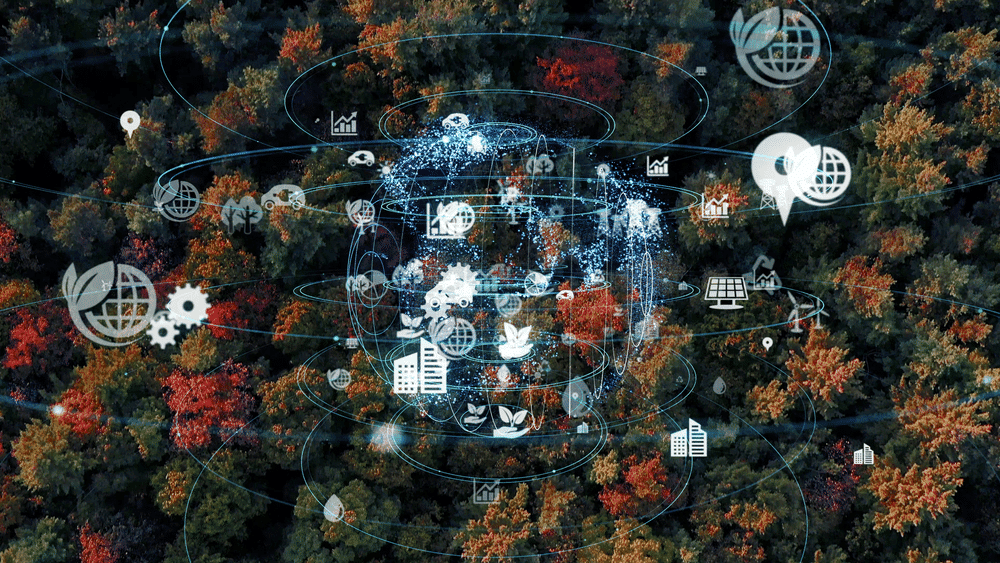
Why in News?
Madhya Pradesh has emerged as the first state in India to pilot an AI-based Real-Time Forest Alert System (RTFAS) aimed at enhancing active forest management. This initiative highlights the role of technology in addressing India’s challenges in sustainable forest management.
Key Takeaways
- Madhya Pradesh implements an AI-based Real-Time Forest Alert System.
- RTFAS integrates satellite technology and machine learning to monitor forests.
- Technology plays a critical role in sustainable forest management efforts.
Additional Details
- AI-based Real-Time Forest Alert System (RTFAS): A cloud-based system that utilizes satellite technology and machine learning to monitor deforestation and land use changes through Google Earth Engine and a custom AI model.
- Key features include real-time monitoring of forest health and the ability to analyze multi-temporal satellite data.
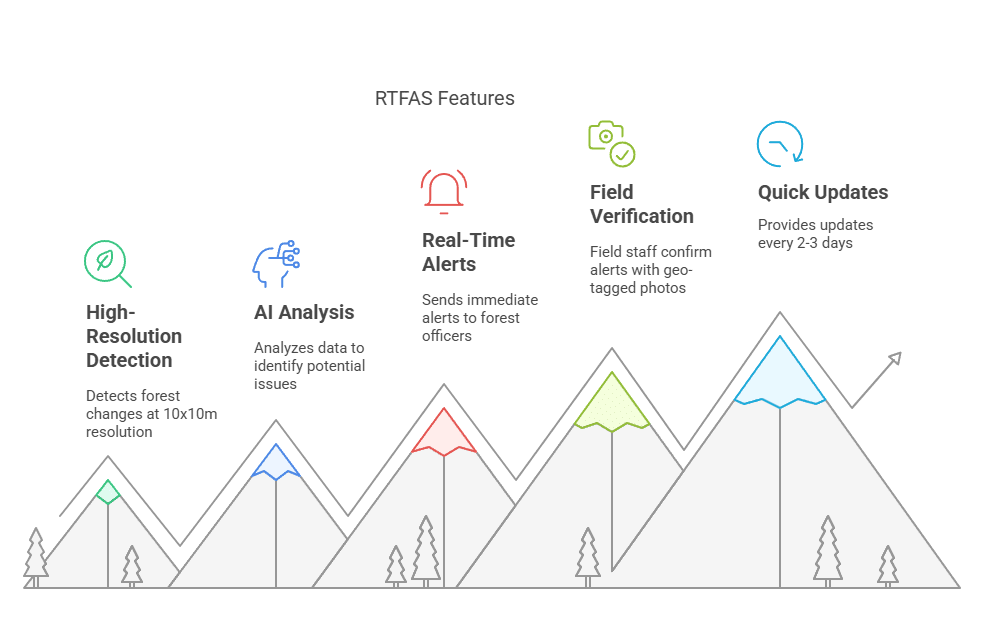
Role of Technology for Sustainable Forest Management
- Forest Carbon Management: High-resolution satellites and hyperspectral imaging assist in assessing forest health and carbon stocks. AI algorithms analyze data to predict deforestation trends.
- Preventing Forest Fires: AI cameras and thermal sensors detect smoke and heat, triggering early fire alerts. Examples include FireSat, a satellite constellation for wildfire detection, and drones that aid in firefighting efforts.
- Combating Encroachment: Satellite systems notify forest officers of unauthorized activities like logging or farming within days.
- Mitigating Human-Wildlife Conflict: AI-enabled camera traps and GPS tracking help monitor animal movements near human settlements, reducing conflicts.
- Forest Restoration and Afforestation: Green bots can track tree growth and soil health, contributing to a comprehensive database of forest health.
- Biodiversity Monitoring: Acoustic sensors are used to track endangered species, while environmental DNA (eDNA) helps monitor aquatic life.
Need for Sustainable Forest Management
- Climate Change Mitigation: Afforestation serves as a carbon sink, absorbing CO₂ and promoting environmental sustainability alongside industrial growth.
- Industrial & Trade Necessity: The EU’s Carbon Border Adjustment Mechanism (CBAM), effective from 2026, will impose tariffs on carbon-intensive imports, making afforestation vital for maintaining trade competitiveness.
- Ecosystem Health: Increasing tree cover helps prevent soil erosion, recharge groundwater, and enhance resilience to extreme weather events.
- Economic and Social Benefits: Sustainable forestry supports industries like timber and fuelwood, providing additional income sources for rural communities.
Initiatives Taken by India for Sustainable Forest Management
- Government-Led Programs:
- Green India Mission (GIM): Increased forest cover by 0.56% between 2017 and 2021.
- National Agroforestry Policy (2014): Encourages tree planting on private farmland to reduce pressure on natural forests.
- Trees Outside Forests in India Program: Promotes tree planting on non-forest lands with private stakeholder involvement.
- Compensatory Afforestation Fund (CAMPA): Supports reforestation where forests are diverted for industrial use.
- Corporate & Community Efforts:
- CSR-Driven Plantations: Companies in sectors like automobile, cement, and energy engage in afforestation to offset emissions.
- Agroforestry for Livelihoods: Farmers integrate timber, fruit, and medicinal plants with crops for additional income.
- Carbon Credit Strategies: Industries invest in afforestation to earn carbon credits.
How India Can Improve Sustainable Forest Management
- Strengthen Carbon Markets: Establish a national carbon credit registry to leverage stored carbon and incentivize afforestation efforts.
- Enhance Industry Participation: Mandate carbon-offset plantations for high-emission industries and offer tax benefits for investments in sustainable forestry.
- Support Rural Communities: Implement Joint Forest Management (JFM) programs and provide training and market access for forest-based products.
- Improve Monitoring & Compliance: Utilize satellite technology for monitoring afforestation and enforce penalties for violations of conservation laws.
Conclusion
India's integration of satellite technologies represents a significant advancement in sustainable forest management. With proactive policies, industry involvement, and community engagement, India can strengthen its forest ecosystems, mitigate climate change, and maintain global competitiveness. Continuous innovation and robust implementation are crucial for achieving long-term economic goals.
Mains Question:
Q: 'Sustainable forest management is essential for balancing ecological preservation with industrial growth.' Evaluate.
Biological Diversity (Access and Benefits Sharing) Regulation, 2025

Why in News?
The National Biodiversity Authority (NBA) has introduced the Biological Diversity (Access and Benefits Sharing) Regulation, 2025 to oversee the distribution of benefits arising from the use of biological resources.
About Biological Diversity (Access and Benefits Sharing) Regulation, 2025
- This updated regulation governs the sharing of benefits generated from the use of biological materials, including digital sequence information and traditional knowledge related to them.
- It replaces the earlier Guidelines Regulations of 2014, which did not cover digital sequence information—an important inclusion, as such data can substitute physical genetic materials.
Key Highlights
Benefit Sharing Based on Turnover: The regulation establishes benefit-sharing rates linked to the annual turnover of the individual or company utilizing the biological resources:
- Additionally, entities with an annual turnover exceeding ₹1 crore must submit an annual statement detailing the biological resources used. For resources deemed to have significant conservation or commercial value, benefit sharing must be at least 5% of the auction or sale proceeds or the purchase price. In cases of commercial usage, the benefit-sharing rate could exceed 20%.
- Valuable and Threatened Resources: This higher benefit-sharing applies to items like red sanders, sandalwood, agarwood, and species listed under Section 38 of the Biological Diversity Act, 2002.
- Digital Sequence Information: The regulation now includes digital sequence information under the definition of genetic resources.
A global benefit-sharing mechanism for such data was established during COP16 of the Convention on Biological Diversity held in Cali, Colombia, in 2024. - Exemption for Cultivated Medicinal Plants: In accordance with the Biological Diversity (Amendment) Act, 2023, users of cultivated medicinal plants are exempted. This move supports the cultivation of medicinal plants and removes the need for traditional medicine practitioners to seek approvals or share benefits. If a product includes both cultivated and wild plants, benefit-sharing requirements may be waived for certain items identified by the MoEFCC in consultation with the Ministry of AYUSH.
- Benefit Sharing by Researchers and Patent Applicants: The regulation specifies benefit-sharing responsibilities for researchers and those applying for intellectual property rights. It also details how the benefits will be distributed among the rightful claimants. Of the total benefits collected, approximately 10–15% will be retained by the National Biodiversity Authority.
About Access and Benefit-Sharing (ABS)
ABS defines how genetic resources can be accessed and how the resulting benefits are shared equitably between users and providers.
- Origin: ABS is based on Article 15 of the Convention on Biological Diversity (CBD), which outlines access and fair benefit-sharing rules.
- Nagoya Protocol to CBD: Adopted in 2010, the Nagoya Protocol provides a binding legal framework for accessing genetic resources and ensuring equitable benefit-sharing. In India, ABS is enforced under the Biological Diversity Act, 2002, and is now operationalized through the ABS Regulation, 2025.
WMO Global Annual to Decadal Climate Update 2025-2029

Why in News?
The World Meteorological Organization (WMO) has published a report entitled “WMO Global Annual to Decadal Climate Update (2025–2029),” indicating that the Earth's average temperature is expected to surpass 1.5°C above pre-industrial levels during this period.
Key Takeaways
- The WMO forecasts that the annual global average temperature from 2025 to 2029 will be between 1.2°C and 1.9°C above the pre-industrial average of 1850–1900.
- There is a 70% probability that the average temperature during this five-year span will exceed the critical threshold of 1.5°C.
- An 86% likelihood exists that at least one year within this timeframe will temporarily exceed the 1.5°C limit.
- There is also an 80% chance that at least one of these years will be hotter than 2024, which currently holds the record for the warmest year.
Additional Details
- Regional Climate Projections:
- South Asia: Anticipated to remain wetter than average.
- Amazon: Expected to experience drier-than-average conditions.
- Arctic: Projected to warm by 2.4°C above normal, which is 3.5 times the global average.
- Paris Agreement Threshold: The year 2024 marked the first full year of recorded temperatures exceeding 1.5°C.
- A long-term exceedance of the 1.5°C threshold (20–30 years) would indicate a failure to meet the goals of the Paris Agreement.
- Urgency for Policy Action: Despite the pressing situation, 180 out of 195 UNFCCC countries have yet to submit their updated Nationally Determined Contributions (NDCs) for 2031–2035, which are crucial for adhering to the 1.5°C limit established in the Paris Agreement.
- The WMO emphasizes the need for ongoing climate monitoring to guide decision-making and enhance adaptation initiatives.
This report underscores the critical state of the global climate and the urgent need for concerted international efforts to mitigate climate change and adhere to established agreements.
Dugong
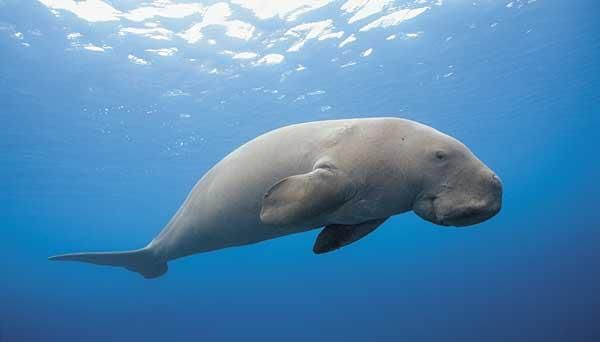
Why in News?
May 28th marks the annual celebration of World Dugong Day, highlighting the importance of this unique marine species.
Key Takeaways
- Dugongs (Dugong dugon) are the only herbivorous mammals found in India's marine ecosystems.
- They are commonly referred to as sea cows and resemble a blend of seals and whales.
- Dugongs inhabit warm waters, primarily around the Andaman and Nicobar Islands, Gulf of Mannar, Palk Bay, and Gulf of Kutch.
- This species can live for up to 70 years.
Additional Details
- Habitat: Dugongs depend on seagrass beds for both habitat and food, leading them to reside in shallow waters where they graze on seagrasses like Cymodocea, Halophila, Thalassia, and Halodule.
- Reproductive Cycle: They reach reproductive maturity at approximately nine to ten years and give birth every three to five years. Due to their slow reproductive cycle, the maximum potential growth rate of dugong populations is estimated at only about 5% per year.
- Conservation Status: The dugong is classified as Vulnerable by the IUCN and is listed in CITES Appendix I. It is also protected under the Wildlife Protection Act of 1972: Schedule I.
- Threats: Dugongs face significant threats from declining populations and the degradation of their seagrass habitats.
In summary, the dugong is a vital species within marine ecosystems, and its conservation is crucial for maintaining the health of these environments. Awareness and protective measures are essential to ensure the survival of this remarkable marine mammal.
World Hydrogen Summit 2025

Why in News?
At the World Hydrogen Summit held in Rotterdam, Netherlands, the Ministry of New & Renewable Energy presented India's strategies aimed at positioning the country as a global leader in the production of green hydrogen.
Key Takeaways
- India's commitment to becoming a global hub for green hydrogen production.
- Introduction of the National Green Hydrogen Mission with specific production targets.
What is Green Hydrogen (GH2)?
- Definition: Green hydrogen is generated by the process of electrolysis, which splits water into hydrogen (H₂) and oxygen (O₂) using energy sourced from renewable means, such as solar power or biomass gasification.
- Applications:Its applications include:
- Fuel cell electric vehicles (FCEVs).
- Industrial applications, particularly in the fertilizers and refineries sectors.
- Transportation sectors, including road and rail.
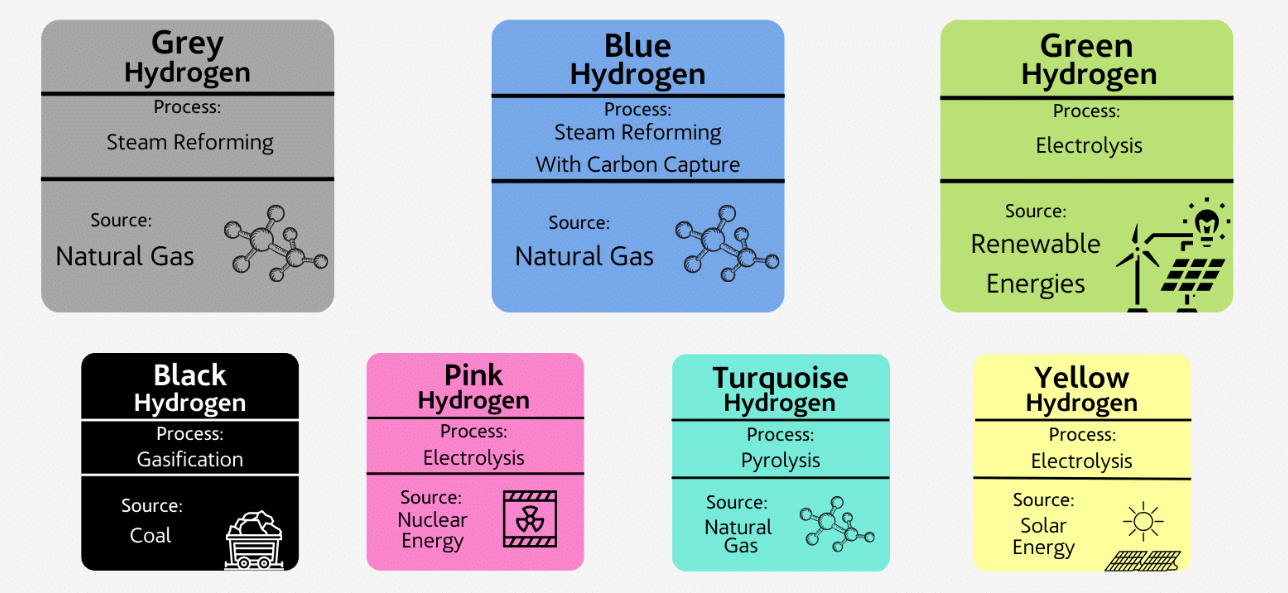
What are India’s Initiatives to Promote Green Hydrogen?
- National Green Hydrogen Mission:This is India's primary policy framework designed to scale up green hydrogen production, targeting an annual capacity of 5 million tonnes by 2030. The mission is divided into two phases:
- Phase I: 2022-23 to 2025-26.
- Phase II: 2026-27 to 2029-30.
- Green Hydrogen Certification Scheme (GHCI): A framework to certify green hydrogen production, focusing on transparency and market credibility. The scheme will be verified by the Bureau of Energy Efficiency (BEE) through an Accredited Carbon Verification (ACV) Agency.
- Environmental Clearance Exemptions: Plants producing green hydrogen and green ammonia are exempt from mandatory environmental clearances, which simplifies and accelerates project implementation.
- Green Hydrogen Hubs: The Ministry of Ports, Shipping and Waterways (MoPSW) has identified three key ports—Kandla, Paradip, and Tuticorin—for development as Green Hydrogen hubs.
- International Collaboration: India has established partnerships with countries like Japan, Australia, and the UAE to facilitate technology transfer and investment in green hydrogen production.
In conclusion, India's initiatives to promote green hydrogen not only aim to bolster its energy independence but also contribute to global sustainability efforts. With structured policies and international collaborations, India is on its path to becoming a significant player in the green hydrogen sector.
16th Asiatic Lion Census 2025
- The number and distribution area of Asiatic Lions has increased, even outside the Gir National Park, showcasing the success of ‘Project Lion.’
- The census, conducted every five years by the Gujarat Forest Department, is part of ongoing efforts to monitor and conserve these lions.
- Launched in 2020, Project Lion aims for the long-term conservation of Asiatic Lions, ensuring they can perform their ecological roles and retain their evolutionary potential.
- The project involves advanced monitoring technologies like radio-collaring and disease management strategies.
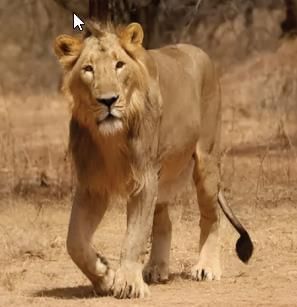
About Asiatic Lion ( Panthera leo persica )
- Habitat: Asiatic Lions inhabit grasslands, savannas, dense scrub, and open woodlands.
- Concentration: They are primarily found in the Gir National Park and Wildlife Sanctuary in Gujarat. Recently, the Barda Wildlife Sanctuary has also become a significant habitat for these lions.
- IUCN Status: The Asiatic Lion is classified as Vulnerable by the International Union for Conservation of Nature (IUCN).
- Legal Protection: Asiatic Lions are listed in Schedule I and IV of the Wildlife (Protection) Act 1972 in India, and in Appendix I of the Convention on International Trade in Endangered Species of Wild Fauna and Flora (CITES).
Characteristics of Asiatic Lion
- Asiatic lions are slightly smaller than their African counterparts.
- A unique feature of Asiatic lions, which is rarely seen in African lions, is a longitudinal fold of skin running along their belly.
- Male Asiatic lions have moderate mane growth on the top of their heads, which makes their ears more visible.
- Unlike some other big cats, lions do not have a specific breeding season.
Initiatives for Conservation
- International Big Cats Alliance (IBCA): Launched in 2023, this initiative strengthens the global commitment to conserving big cats, including lions.
- Greater Gir Concept: This initiative aims to develop additional suitable habitats for lions beyond the Gir National Park and Sanctuary.
- Sanctuary Expansion: Sanctuaries such as Girnar, Pania, and Mitiyala have been notified to expand the protected area network for lions.
- Asiatic Lion Reintroduction Project: This project proposes the reintroduction of Asiatic lions in Kuno National Park, Madhya Pradesh.
- Advanced Monitoring Technologies: AI-driven systems like SIMBA, E-GujForest, and Alert Generation System are being used for monitoring lions.
|
95 videos|231 docs|52 tests
|
FAQs on Environment and Ecology: May 2025 UPSC Current Affairs - Environment for UPSC CSE
| 1. What is the significance of India's Arctic outlook in the context of global geopolitics? |  |
| 2. What are the health and environmental concerns associated with chlorpyrifos? |  |
| 3. How can modern technology contribute to sustainable forest management? |  |
| 4. How does climate change impact the Arctic region, and what are its implications for India? |  |
| 5. What are the key measures proposed for the sustainable management of forests in India? |  |





















